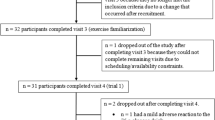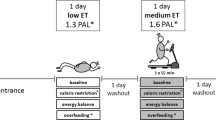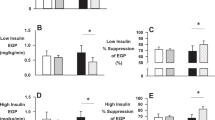Abstract
Objective:
To determine the glycemic index (GI) dependence on the training state of healthy adult males.
Subjects and design:
Young, adult males of normal body mass index and normal glucose tolerance were tested twice with a 50 g reference glucose solution and twice with a breakfast cereal containing 50 g of available carbohydrates in a randomized order. Ten subjects were sedentary (SE), 12 were moderately trained (MT) and 12 were endurance trained (ET). Blood glucose, insulin and glucagon were measured.
Results:
The GI differed significantly between SE and ET subjects (P=0.02, mean difference: 23 GI units, 95% CI=3–42 GI units). The GI of the MT subjects was intermediary, but did not differ significantly from the SE or ET subjects. The insulin index did not differ significantly between the groups (P=0.65).
Conclusion:
The GI of the commercially available breakfast cereal depended on the training state of the healthy males. The training state is the first reported factor influencing the GI that is subject specific rather than food specific.
This is a preview of subscription content, access via your institution
Access options
Subscribe to this journal
Receive 12 print issues and online access
$259.00 per year
only $21.58 per issue
Buy this article
- Purchase on Springer Link
- Instant access to full article PDF
Prices may be subject to local taxes which are calculated during checkout

Similar content being viewed by others
References
Borissova AM, Tankova T, Kirilov G, Koev D (2005). Gender-dependent effect of ageing on peripheral insulin action. Int J Clin Pract 59, 422–426.
Brouns F, Bjorck I, Frayn KN, Gibbs AL, Lang V, Slama G et al. (2005). Glycaemic index methodology. Nutr Res Rev 18, 145–171.
Buchfuhrer MJ, Hansen JE, Robinson TE, Sue DY, Wasserman K, Whipp BJ (1983). Optimizing the exercise protocol for cardiopulmonary assessment. J Appl Physiol 55, 1558–1564.
Campbell J, Glowczewski T, Wolever TM (2003). Controlling subjects’ prior diet and activities does not reduce within-subject variation of postprandial glycemic responses to foods. Nutr Res 23, 621–629.
FAO/WHO (1998). Carbohydrates in Human Nutrition: Report of a Joint FAO/WHO Expert Consultation. FAO/WHO: Rome.
Foster-Powell K, Holt SH, Brand-Miller JC (2002). International Table of Glycemic Index and Glycemic Load Values: 2002. Am J Clin Nutr 76, 5–56.
Granfeldt Y, Wu X, Bjorck I (2006). Determination of glycaemic index; some methodological aspects related to the analysis of carbohydrate load and characteristics of the previous evening meal. Eur J Clin Nutr 60, 104–112.
Jackson AS, Pollock ML, Ward A (1980). Generalized equations for predicting body density of women. Med Sci Sports Exerc 12, 175–181.
Jenkins DJ, Jenkins AL (1985). Dietary fiber and the glycemic response. Proc Soc Exp Biol Med 180, 422–431.
Jenkins DJ, Wolever TM, Taylor RH, Barker H, Fielden H, Baldwin JM et al. (1981). Glycemic index of foods: a physiological basis for carbohydrate exchange. Am J Clin Nutr 34, 362–366.
McCleary BV, Gibson TS, Mugford DC (1997). Measurement of total starch in cereal products by amyloglucosidase–alpha–amylase method: Collaborative Study. J AOAC Int 80, 571–579.
McCleary BV, McNally M, Rossiter P (2002). Measurement of resistant starch by enzymatic digestion in starch and selected plant materials: collaborative study. J AOAC Int 85, 1003–1111.
Mettler S, Wenk C, Colombani PC (2006). Influence of the training status on the glycemic index. Int J Vitam Nutr Res 76, 39–44.
Nassis GP, Papantakou K, Skenderi K, Triandafillopoulou M, Kavouras SA, Yannakoulia M et al. (2005). Aerobic exercise training improves insulin sensitivity without changes in body weight, body fat, adiponectin, and inflammatory markers in overweight and obese girls. Metabolism 54, 1472–1479.
Owen B, Wolever TM (2003). Effect of fat on glycaemic responses in normal subjects: a dose–response study. Nutr Res 23, 1341–1347.
Rogers MA, King DS, Hagberg JM, Ehsani AA, Holloszy JO (1990). Effect of 10 days of physical inactivity on glucose tolerance in master athletes. J Appl Physiol 68, 1833–1837.
Schenk S, Davidson CJ, Zderic TW, Byerley LO, Coyle EF (2003). Different glycemic indexes of breakfast cereals are not due to glucose entry into blood but to glucose removal by tissue. Am J Clin Nutr 78, 742–748.
Siri WE (1993). Body composition from fluid spaces and density: analysis of methods. 1961. Nutrition 9, 480–491.
Spiller GA, Jensen CD, Pattison TS, Chuck CS, Whittam JH, Scala J (1987). Effect of protein dose on serum glucose and insulin response to sugars. Am J Clin Nutr 46, 474–480.
Unwin N, Shaw J, Zimmet P, Alberti KG (2002). Impaired glucose tolerance and impaired fasting glycaemia: the current status on definition and intervention. Diabet Med 19, 708–723.
Wolever TM, Vorster HH, Bjorck I, Brand-Miller J, Brighenti F, Mann JI et al. (2003). Determination of the glycaemic index of foods: Interlaboratory Study. Eur J Clin Nutr 57, 475–482.
Young JC, Enslin J, Kuca B (1989). Exercise intensity and glucose tolerance in trained and nontrained subjects. J Appl Physiol 67, 39–43.
Zhang YY, Johnson MC, Chow N, Wasserman K (1991). Effect of exercise testing protocol on parameters of aerobic function. Med Sci Sports Exerc 23, 625–630.
Acknowledgements
We thank Astrid Peterhans, Fabienne Schwitz and Patricia Kressig for their medical assistance, and the Swiss Foundation for Nutrition Research and the Federal Council of Sports for partially funding this study.
Author information
Authors and Affiliations
Corresponding author
Additional information
Study data have not been previously published and are not currently submitted for publication.
Guarantor: PC Colombani.
Contributors: SM was responsible for and coordinated the execution of the study and laboratory analysis, performed the statistical analysis and drafted the manuscript. SM, CW and PCC obtained the funding, planned and designed the study. SM, FLR and NSK executed the study. PCC edited the manuscript and FLR, NSK and CW commented on the manuscript.
Rights and permissions
About this article
Cite this article
Mettler, S., Lamprecht-Rusca, F., Stoffel-Kurt, N. et al. The influence of the subjects’ training state on the glycemic index. Eur J Clin Nutr 61, 19–24 (2007). https://doi.org/10.1038/sj.ejcn.1602480
Received:
Revised:
Accepted:
Published:
Issue Date:
DOI: https://doi.org/10.1038/sj.ejcn.1602480
Keywords
This article is cited by
-
Glycaemic index of meals affects appetite sensation but not energy balance in active males
European Journal of Nutrition (2014)
-
Metabolic responses to high glycemic index and low glycemic index meals: a controlled crossover clinical trial
Nutrition Journal (2011)
-
Influence of test interval length on the variability of glycemic response tests
European Journal of Clinical Nutrition (2009)
-
Glycemic index and glycemic load: measurement issues and their effect on diet–disease relationships
European Journal of Clinical Nutrition (2007)



